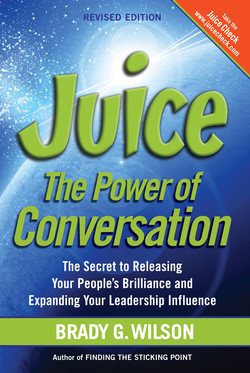Читать книгу Juice - Brady G. Wilson - Страница 12
На сайте Литреса книга снята с продажи.
ОглавлениеHarnessing the Power of Context
WE’VE discovered that Pull Conversations have a logic to them. Blending inquiry and directness fosters feelings of respect and trust in others. This, in turn, calms them and increases their capacity to understand. Inquiry and directness are perfectly suited to get us to a Bigger Reality, and getting to a Bigger Reality tends to release intelligent energy in our environment.
This chapter demonstrates the results that come from pulling out context. It highlights inquiry as the most effective attitude for uncovering the context we need.
Putting Context into Context
Understanding Produces Context
One of the richest rewards of pulling out someone’s reality is context: the ability to see as a sensible whole what others see as disconnected parts. Context is a clear picture of the beliefs, values, and emotional needs that motivate another’s actions. And context is produced by understanding.
For example, when Bill, as related in the previous chapter, pulled out the concerns and goals of the Atomic Energy Commission, he gained an understanding of their reality. This gave him context regarding how his concerns and theirs could be reconciled. He was then able to frame his message in a way that appealed to their interests. Context made him effective.
Context is a critical ingredient of success in every area of life. It informs you in hundreds of ways about what actions and decisions will yield the best result as you deal with people. Whether you’re throwing someone a surprise party or negotiating a complex business deal, understanding the context of someone’s beliefs, values, and emotional needs enables you to choose the approach that will work best for them.
When you interpret and anticipate others’ behaviors, you develop relational radar: the ability to detect what’s coming at you before it arrives. Relational radar tells you how to be appropriate in any situation.
In Peak Performers, Charles Garfield tells a story that illustrates how intelligent energy is released through interpreting context accurately. He relates how a member of the New York consulting firm Inferential Focus spun four lines he read in the Wall Street Journal into great profits for his firm’s clients. According to these four lines, Saudi Arabia was making a major change in the shipping requirements for incoming goods. Their country had decided to reduce the size of the containers by 50% and were moving from inspecting 80% of them to inspecting all of them.
“The consultant suspected fear of terrorism,” Garfield writes. “The Saudis were known to respond to fear by stashing their oil money in a safe place – gold. Inferential Focus told its clients to buy gold. Six weeks later, the value of the gold had doubled.”
What Is Context?
Context is the environment that surrounds or influences something. Think of a beautiful wall hanging, perhaps a rendition of the Last Supper. There is a specific black thread that makes up the pupil of Peter’s eye. The white and beige threads adjacent to the black thread are the environment that surround and influence it. The different components are woven together and make up the eye and, in a global sense, the whole picture.
This is a particularly apt analogy, because context literally means to weave together (com = together; texere = to weave).
